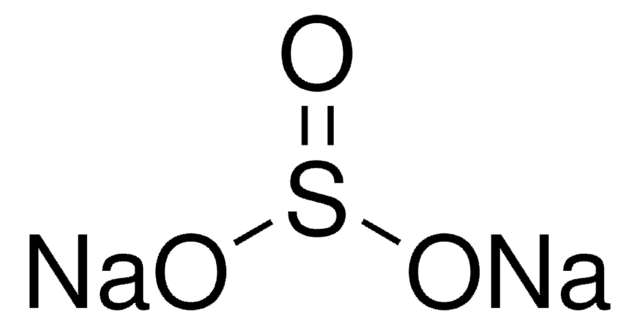13459
Sodium metabisulfite
puriss., meets analytical specification of Ph. Eur., BP, NF, FCC, E223, dry, 97-100.5%
Synonyme(s) :
Sodium disulfite, Sodium pyrosulfite
About This Item
Produits recommandés
Qualité
puriss.
dry
meets analytical specification of Ph. Eur., BP, NF, FCC, E223
Niveau de qualité
Essai
97-100.5%
Forme
powder or crystals
Composition
SO2, 65.0-67.4%
Impuretés
residue of solvents, complies
≤0.02% thiosulfate (S2O3)
pH
3.5-5.0 (20 °C, 5%)
Pf
>300 °C (lit.)
Traces d'anions
chloride (Cl-): ≤100 mg/kg
Traces de cations
As: ≤2 mg/kg
Cu: ≤10 mg/kg
Fe: ≤10 mg/kg
Hg: ≤1 mg/kg
Pb: ≤2 mg/kg
Se: ≤5 mg/kg
Zn: ≤10 mg/kg
Adéquation
complies for appearance of solution
Chaîne SMILES
[Na+].[Na+].[O-]S(=O)S([O-])(=O)=O
InChI
1S/2Na.H2O5S2/c;;1-6(2)7(3,4)5/h;;(H,1,2)(H,3,4,5)/q2*+1;/p-2
Clé InChI
HRZFUMHJMZEROT-UHFFFAOYSA-L
Vous recherchez des produits similaires ? Visite Guide de comparaison des produits
Catégories apparentées
Description générale
Application
Mention d'avertissement
Danger
Mentions de danger
Conseils de prudence
Classification des risques
Acute Tox. 4 Oral - Eye Dam. 1
Risques supp
Code de la classe de stockage
11 - Combustible Solids
Classe de danger pour l'eau (WGK)
WGK 1
Point d'éclair (°F)
Not applicable
Point d'éclair (°C)
Not applicable
Faites votre choix parmi les versions les plus récentes :
Déjà en possession de ce produit ?
Retrouvez la documentation relative aux produits que vous avez récemment achetés dans la Bibliothèque de documents.
Les clients ont également consulté
Notre équipe de scientifiques dispose d'une expérience dans tous les secteurs de la recherche, notamment en sciences de la vie, science des matériaux, synthèse chimique, chromatographie, analyse et dans de nombreux autres domaines..
Contacter notre Service technique










